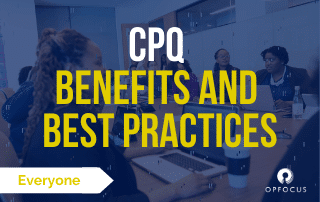Getting Started – CPQ Benefits and Best Practices
 Retention is the key to growth. We say it all the time because it’s worth repeating. Companies that reduce the churn see far more growth than those with high turnover. As a result, companies are trying to make renewals as frictionless as possible. Salesforce CPQ is a great way to do so but many teams have questions about getting started and best practices. OpFocus recently had an open discussion around renewals and CPQ best practices with our CEO, David Carnes, and Director of CPQ Consulting, David Movsesian. Let’s cover CPQ Benefits and Best Practices so your team can determine if it’s the right fit!
Retention is the key to growth. We say it all the time because it’s worth repeating. Companies that reduce the churn see far more growth than those with high turnover. As a result, companies are trying to make renewals as frictionless as possible. Salesforce CPQ is a great way to do so but many teams have questions about getting started and best practices. OpFocus recently had an open discussion around renewals and CPQ best practices with our CEO, David Carnes, and Director of CPQ Consulting, David Movsesian. Let’s cover CPQ Benefits and Best Practices so your team can determine if it’s the right fit!
What are the aspects of renewals and what data should we be tracking?
To get things started, a question was raised about the different facets to consider when thinking about renewals and what type of data your team should be considering. In order to make things easy to understand, David broke renewals down according to some key questions you should be able to answer.
KEY ASPECTS OF RENEWALS:
- What renewable subscriptions does the customer own?
- What is the quantity to be renewed?
- When is the renewal date?
- What is the term of the subsequent renewal?
- How is the renewal to be priced?
- Is the contract to be auto-renewed?
After reviewing these questions, can you answer all of them for each of your customers? This information is the core of any renewal and required for the process to be successful. An understanding of what they own, what they pay, and when they are up for renewal are especially crucial. Many companies have this information floating around their system but aren’t able to easily locate it.
David mentioned he’s seen companies that have been charging the same price for 10 years when the price should have been increased. The renewal representative was not able to find the information they needed, and as a result, money was left on the table. This demonstrates just how important it is that you keep track of this information and it’s easily accessible by your team.
What are Common Pain Points CPQ Solves?
So is CPQ right for you? Well, the answer to this can take a bit of explanation. CPQ solves specific problems. David recommends CPQ for teams that have difficulty with the configuration or actual management of a renewal. David outlines a number of issues that CPQ solves to help teams like yours understand if it’s the right fit.
COMMON PAIN POINTS WITHOUT CPQ:
- Poor visibility of existing subscriptions and assets
- Contracts often stored documents or as paper!
- Renewals require users to research what a client owns and pricing
Often, no definition of renewal pricing or special terms
- Poor visibility of renewal pipeline
- Some clients clone Opportunities upon closed-won with a future date to serve as a renewal Opportunity, but these Opps are not maintained when add-ons or expansions occur. They are often static and inaccurate
- No visibility of Transaction Types for Reporting
- New Business
- Add-on (Amendment, Renewal)
- Expansion/Contraction (Amendment, Renewal)
- Churn (Amendment, Renewal)
- Difficult to track Renewal Success
-
- Poor or no visibility of metrics
- MRR Available for Renewal
- Renewed MRR
- Expansion MRR
- Add-on MRR
- Churn MRR
- Poor or no visibility of metrics
This is not an exhaustive list and there are a number of other reasons your team may want to bring on CPQ. When looking at these topics however, they provide insight into areas of your renewal process that can be working more efficiently. So again, is CPQ right for you? You’ll need to evaluate your current renewal process to see if there are areas you’d like to improve.
What are the Benefits of CPQ?
Going beyond the issues CPQ solves, it’s necessary to consider the benefits it offers. Having all your renewal information in one place provides visibility into the renewal pipeline and helps your team forecast more effectively. It also automates a number of actions your team would otherwise need to complete manually. David outlines a number of other advantages that the platform provides.
BENEFITS OF CPQ
-
-
- A customer’s subscriptions and assets are stored in Salesforce
- Renewal Opportunity is automatically generated when a contract is activated
- Provides visibility of future revenue from upcoming renewals
- The Renewal Opportunity will be updated automatically if amendments are processed
- Provides an accurate view of a customer’s subscriptions
- No need for research at renewal time
- Renewals can be fully automated if desired
- Set the Renewal Pricing Method for each client
- Renewals can be processed quickly without having to research
- Same
- List
- Uplift
- Renewals can be processed quickly without having to research
- Visibility of Transaction Types for Reporting
- New Business
- Add-on (Amendment, Renewal)
- Expansion/Contraction (Amendment, Renewal)
- Churn (Amendment, Renewal)
- Measure Renewal Success:
- MRR Available for Renewal
- Renewed MRR
- Expansion MRR
- Add-on MRR
- Churn MRR
- Ability to merge and co-term contracts on renewal
-
As you can see, Salesforce CPQ goes far beyond solving the challenges many people bring it on for. Through CPQ, your team will become more effective at handling renewals and can identify areas of improvement in other parts of the business. These benefits will determine if CPQ is a good fit.
What are some Best Practices for Contract Management?
Once your team decides to bring on Salesforce CPQ, there are some best practices you should be aware of. This is a good list to start with, but an entire discussion can take place around CPQ best practices. David outlines the most important points your team will need to be aware of.
CONTRACT MANAGEMENT BEST PRACTICES
-
-
- Use standard Amendments for all addons and expansions
- Enforce Cotermination for all amendments!
- Do not generate a Renewal Quote unless you need it to avoid amendment issues during the renewal window
- Never make modifications to a contract that can impact pricing
-
These ensure your team is using the system effectively and will help avoid potential issues down the line. As your team uses CPQ, you should keep these points in mind. Again, this is not an exhaustive list but will provide guidance on how to prevent some of the more common problems that professionals tend to run into.
Final Thoughts
As your team evaluates CPQ or begins your next project, these guidelines will help make informed decisions. This article has covered the challenges CPQ solves, and best practices to help your team better determine the next steps. As a next step, you’ll likely want to look into some of the top tips for ensuring a Salesforce CPQ project goes smoothly. Discover the importance of including stakeholders at the beginning of a project and how to avoid delays. When it’s time to discuss your next project, reach out to David or another member of our team. We understand the importance of tailoring CPQ to your organization and offer insight into the best solution for your organization.
-


